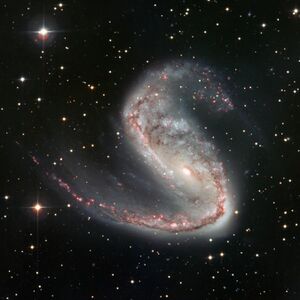Astronomy:NGC 2442 and NGC 2443
| NGC 2442 / 2443 | |
|---|---|
 NGC 2442 (upper spiral structure) and NGC 2443 (lower horizontal spiral arm)[1] | |
| Observation data (J2000 epoch) | |
| Constellation | Volans |
| Right ascension | 07h 36m 23.8s[2] |
| Declination | −69° 31′ 51″[2] |
| Redshift | 1466 ± 5 km/s[2] |
| Apparent magnitude (V) | 11.2[2] |
| Characteristics | |
| Type | SAB(s)bc pec[2] |
| Apparent size (V) | 5′.5 × 4′.9[2] |
| Notable features | SW part is NGC 2442 while NE part is NGC 2443 |
| Other designations | |
| PGC 21373[2] | |
NGC 2442 and NGC 2443 are two parts of a single intermediate spiral galaxy, commonly known as the Meathook Galaxy or the Cobra and Mouse.[3] It is about 50 million light-years away in the constellation Volans. It was discovered by Sir John Herschel on December 23, 1834 during his survey of southern skies with a 18.25 inch diameter reflecting telescope (his "20-foot telescope") from an observatory he set up in Cape Town, South Africa.[4] Associated with this galaxy is HIPASS J0731-69, a cloud of gas devoid of any stars.[5] It is likely that the cloud was torn loose from NGC 2442 by a companion.[5]
When John Louis Emil Dreyer compiled the New General Catalogue of Nebulae and Clusters of Stars he used William Herschel's earlier observations that described two objects in a "double nebula", giving the northern most the designation NGC 2443 and the southernmost most the designation NGC 2442. Herschel's later observations noted that the two objects were actually a single large nebula.[4][6]
Supernovae
Two supernovae have been observed in NGC 2442: SN 1999ga (type II, mag. 18),[7] and SN 2015F (type Ia, mag. 16.8).[8]
Gaia16cfr was a supernova imposter that occurred in NGC 2442 on 1 December 2016. It reached a Gaia apparent magnitude of 19.3 and absolute magnitude of about −12.[9]
References
- ↑ NGC/IC Project Restoration Effortngcicproject.observers.org
- ↑ 2.0 2.1 2.2 2.3 2.4 2.5 2.6 "NASA/IPAC Extragalactic Database". Results for NGC 2442 / 2443. http://ned.ipac.caltech.edu/byname?objname=NGC+2442.
- ↑ Chadwick, S; Cooper, I (11 December 2012). Imaging the Southern Sky. New York: Springer. p. 263. ISBN 978-1461447498.
- ↑ 4.0 4.1 Seligman, Courtney. "Celestial Atlas: NGC Objects: NGC 2400 - 2449". http://cseligman.com/text/atlas/ngc24.htm#2443.
- ↑ 5.0 5.1 Ryder, S.D. (July 2001). "HIPASS Detection of an Intergalactic Gas Cloud in the NGC 2442 Group". The Astrophysical Journal 555 (1): 232–239. doi:10.1086/321453. Bibcode: 2001ApJ...555..232R.
- ↑ NGC/IC Project Restoration Effortngcicproject.observers.org
- ↑ Transient Name Server entry for SN 1999ga. Retrieved 31 March 2023.
- ↑ Transient Name Server entry for SN 2015F. Retrieved 31 March 2023.
- ↑ Kilpatrick, Charles D.; Foley, Ryan J.; Drout, Maria R.; Pan, Yen-Chen; Panther, Fiona H.; Coulter, David A.; Filippenko, Alexei V.; Marion, G. Howard et al. (2018). "Connecting the progenitors, pre-explosion variability and giant outbursts of luminous blue variables with Gaia16cfr". Monthly Notices of the Royal Astronomical Society 473 (4): 4805. doi:10.1093/mnras/stx2675. Bibcode: 2018MNRAS.473.4805K.
External links
- NGC 2442 in Volans
- Astronomy Picture of the Day
- NGC 2442: Galaxy in Volans 2007 March 15
- NGC 2442: Galaxy in Volans 2010 March 25 - from Hubble Space Telescope data
- NGC 2442: Galaxy in Volans 2017 August 17- from Hubble Space Telescope and European Southern Observatory data
- NGC 2442 and NGC 2443 on WikiSky: DSS2, SDSS, GALEX, IRAS, Hydrogen α, X-Ray, Astrophoto, Sky Map, Articles and images
Coordinates: ![]() 07h 36m 23.8s, −69° 31′ 51″
07h 36m 23.8s, −69° 31′ 51″
 |

